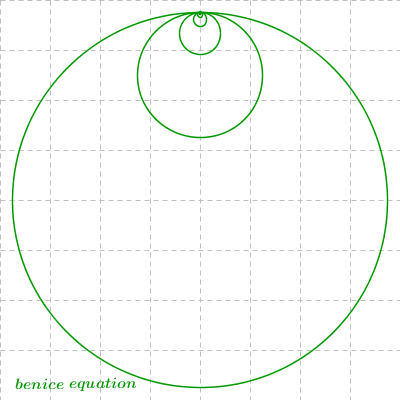( Click on the image for a larger view. )
( Click on the image for a larger view. )
( Click on the image for a larger view. )
( Click on the image for a larger view. )
( Click on the image for a larger view. )
( Click on the image for a larger view. )
( Click on the image for a larger view. )
( Click on the image for a larger view. )
(A few images of successive zooming in on the small region are shown below.)
( Click on the image for a larger view. )
( Mathematical softwares used: GeoGebra, gnuplot )
Related posts:




















The 5th looks most like a snow-flake! Very cool.
ReplyDeleteDo you choose the speed of spinning randomly and see what will happen or you chose them for a reason? :-)
ReplyDeleteSpeed(n) = k^(n-1), k=±2, ±3, ±4, ....
DeleteThe ratios between the size of the various circles set the limits of the function/expression, and being circular makes the results finite, so the end result is a fractal set, correct?
DeleteHow many circles are there in the first image ?
ReplyDelete10 (or 11) circles for the first dynamic image and 100 (or 101) circles for the first static image.
DeleteDo you have skype or something, so I can contact you because I have some questions ;)
ReplyDeleteYou can ask questions here.
DeleteHi Mr. Chen, I am a high school student studying computer science. These images have inspired me to create a program which simulates the patterns in them based on the following user inputted modifiers: number of circles, circle speed multiplier, circle size divisor, and circle direction (same or opposite). I have only created this program for individual educational purposes and will give you full credit when submitting it to my teacher.
ReplyDeleteI have had no trouble creating this program, but at this point I would like to display the parametric equations of the pattern based on the user inputted modifiers. Is there any general parametric equation based on the inputted modifiers which can model these patterns?
Thank you in advance,
Jonathan
Hi SabayonCompiz,
DeleteThe most general parametric equation is:
x(t) = Σ(k=1 to n) R(k)*cos(a(k)*t)
y(t) = Σ(k=1 to n) R(k)*sin(a(k)*t)
Here's an example in Graph:
http://forum.padowan.dk/viewtopic.php?id=721
what are R(k) and a(k)?
DeleteHi, sorry for being anonymus, but somehow i cant login in any way.
ReplyDeleteI would like to build those spirals on GeoGebra, but sadly i have no idea how to manage this (my GeoGebra skills are pretty limited since i just started using it).
Do you by any chance give away samples of your constructions?
Hi, here is an example:
Deletehttp://www.geogebra.org/forum/download/file.php?id=13233&sid=25fe6f018879848d132b7c652eea36f9
Hello,
ReplyDeleteThis is fascinating and I'm well down the rabbit hole enjoying both the math refresher and the plotting. I would like to try this in GeoGebra but would benefit greatly from an example. The link above does not seem to work- can you please refresh?
I tried recreating this in p5 and almost got it but i cant seem to figure out the ratio of the sizes of the circles , would you be able to help?
ReplyDeletehttps://math.stackexchange.com/questions/1834607/fractal-identification?rq=1
ReplyDeleteDear,
ReplyDeletethank you to share your work and I have a question
if I have 4 circles with dia = 1,2,4,8 how the movement will be for a point belong to smallest circle, can you please build the module, I need it for my research
Truly amazing!
ReplyDelete